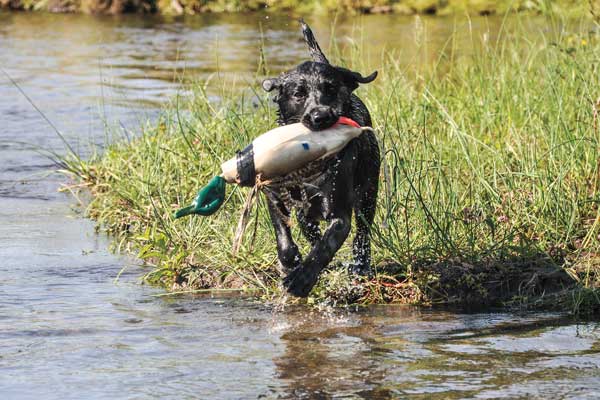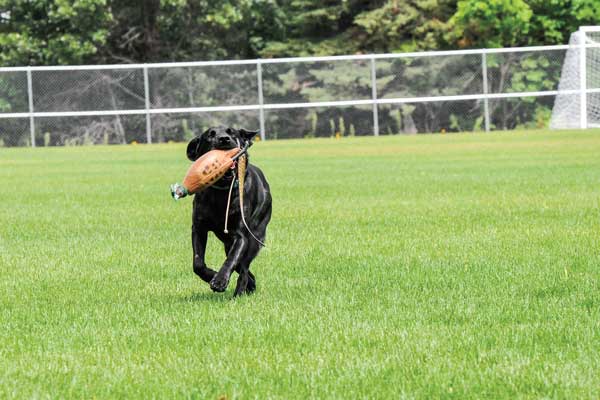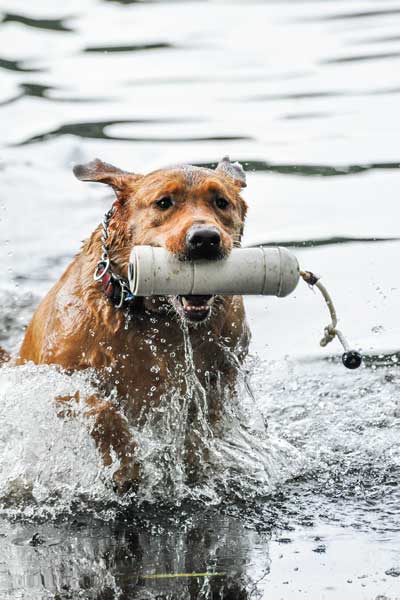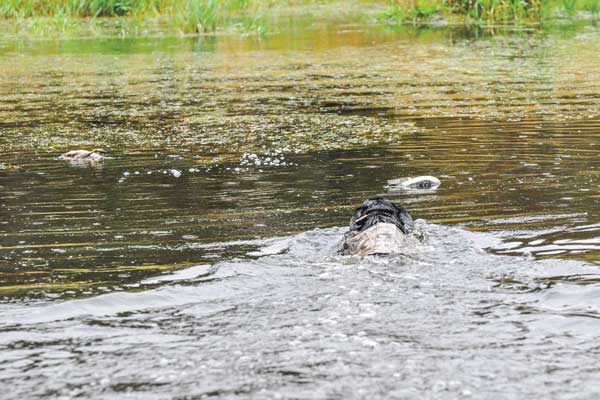June 03, 2015
By Tom Dokken
 Good duck dogs need to know how to count — at least to two, anyway. Eventually, they should be able to count to three, but that's fodder for a different column. Most retriever owners recognize the need for their dogs to be able to successfully retrieve a double, but some fall short in their training.
Good duck dogs need to know how to count — at least to two, anyway. Eventually, they should be able to count to three, but that's fodder for a different column. Most retriever owners recognize the need for their dogs to be able to successfully retrieve a double, but some fall short in their training.
If you're eyeing up a few drills to help your dog master doubles, take a long hard look at his single retrieves. Any dog expected to graduate to doubles needs to flawlessly handle single retrieves.
If your dog's game is a bit off when chasing down a solo dummy, it's going to be a disaster when you introduce another. All of the obedience necessities need to be rock solid, as does the entire process of retrieving a single to hand before you consider going for doubles.
If, however, your dog possesses the foundation of perfect single retrieves on land and in the water, then it's definitely time to prepare him for making multiple retrieves.
Advertisement
A Simple 180
As with all my drills, the first lesson concerning doubles is very simple to master. This drill requires two highly-visible dummies and a mowed lawn, and is designed to encourage memory development. With the dog at heel, I'll throw a dummy a short distance to my right. Then, I toss the second dummy to my left.
The reason for tossing the dummies in completely opposite directions is to encourage the dog to retrieve the first dummy and return to me before he thinks about the second. After tossing the dummies, I'll send the dog to the last dummy first and call him to hand.
Advertisement
If he returns the dummy to me correctly, he gets sent in the opposite direction to retrieve the first dummy. It's imperative this stage of the process be simple and the dog can easily see the dummies. Success breeds confidence, which comes in handy as we increase the difficulty.
If your dog seems to have any problems with this initial 180 drill, you may need to employ a check cord. No matter what, he should not be running to the second dummy until he has brought you the first.
This drill, although simple, should be conducted daily for a week or so until it's easy for your dog to accomplish. If your dog gets it quickly in the backyard, feel free to change locations, but always remember to keep it easy enough to encourage success. This is not the time to test your dog.
Collapse The Angle
After mastering the 180 drill, I like to stay in the backyard and throw the dummies 45 degrees apart. This allows the dog to see both dummies, so don't be surprised if there is some hesitation or obedience issues at the onset. Again, encourage the dog to retrieve the last dummy first, and then retrieve the first-thrown dummy on memory.
If the 45-degree drill comes along nicely, I like to add a thrower into the mix provided the dog has previous experience with a handler and a thrower. If so, have your thrower get the dog's attention and then toss the dummy. Once it's tossed, you should then throw your dummy in the opposite direction a full 180 degrees away from the first retrieve. If your dog masters this drill, tighten it up to 45 degrees as well.
If at any point throughout the doubles training your dog runs into serious issues staying on track, stop immediately. Take a few steps back and re-work some of the earlier drills. Eventually, your dog will be ready to move on.
Pattern Memory
When your duck dog has aced his drills thus far, it's time to head to the nearest football field. Have your thrower stand on the goal line and back up 25 yards. Your partner should then toss a single retrieve, and you should send your dog. If it goes well, back up another 25 yards and repeat. Keep this up until your dog is retrieving singles at a full 100 yards.
 At this point, return to the 25-yard mark and have the thrower toss the dummy. Once tossed, throw your own dummy as well, and then send your dog. When he brings it to hand, send him for the farther dummy.
At this point, return to the 25-yard mark and have the thrower toss the dummy. Once tossed, throw your own dummy as well, and then send your dog. When he brings it to hand, send him for the farther dummy.
Again, provided things go well, increase the distance of the memory retrieve (the helper's dummy). Eventually, your dog should be able to retrieve the dummy you toss and then conduct a second memory retrieve up to 100 yards away.
This may take five days, or it may take weeks, but it's worth it to build your dog's confidence and help them learn to retrieve on memory.
If you don't have a helper for these drills, you can still conduct the farther retrieve doubles, it just takes longer. Your dog needs to be able to stay or be placed so that you can run out and toss the long retrieve, and then come back to also toss the shorter retrieve.
Conversely, if you have the opportunity to add in a second thrower, by all means do it. This gives you the chance to just control the dog while your two training partners throw the dummies and vary (increase) the length of both retrieves. This changes the dynamics and difficulty of the drill and allows you to monitor simply as the handler.
Advanced work
 If the soccer-field training goes well enough, it's time to start over with the simple 180 drills and work the process again. However, this time will involve new terrain: tall grass, varied locations and then water. I like to pay special attention to the wind when training in tall grass and use wax-based scents on my dummies to encourage the dog to use his nose as well as his eyes.
If the soccer-field training goes well enough, it's time to start over with the simple 180 drills and work the process again. However, this time will involve new terrain: tall grass, varied locations and then water. I like to pay special attention to the wind when training in tall grass and use wax-based scents on my dummies to encourage the dog to use his nose as well as his eyes.
It's obviously easier to conduct these drills on land than in the water, especially the long-distance doubles, but do your best to find locations that allow you to train as well as possible. Shallow creeks, or hip-wader-friendly ponds are great spots to work on these drills in realistic locations.
As your dog gets more experience working double drills, he'll start to believe that there might be multiple birds to retrieve every time he is sent out. This instills confidence that goes a long ways in the duck boat or blind when two birds do hit the water and your dog is going to be tasked with bringing them both to hand.
This is especially important if your dog doesn't actually see both birds go down, which is very common when crouched in the cattails or corn stubble and the melee of an approaching flock and subsequent volley of shots causes a bit of chaos for human and hound alike.

